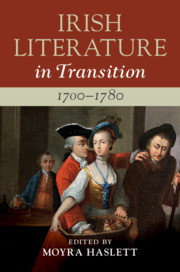Book contents
- Irish Literature in Transition, 1700–1780
- Irish Literature in Transition
- Irish Literature in Transition, 1700–1780
- Copyright page
- Contents
- Illustrations
- Contributors
- Series Preface
- General Acknowledgements
- Introduction
- Part I Starting Points
- Part II Philosophical and Political Frameworks
- Part III Local, National, and Transnational Contexts
- Part IV Gender and Sexuality
- Part V Transcultural Contexts
- Part VI Retrospective Readings
- Index
Introduction
Published online by Cambridge University Press: 28 February 2020
- Irish Literature in Transition, 1700–1780
- Irish Literature in Transition
- Irish Literature in Transition, 1700–1780
- Copyright page
- Contents
- Illustrations
- Contributors
- Series Preface
- General Acknowledgements
- Introduction
- Part I Starting Points
- Part II Philosophical and Political Frameworks
- Part III Local, National, and Transnational Contexts
- Part IV Gender and Sexuality
- Part V Transcultural Contexts
- Part VI Retrospective Readings
- Index
Summary
In this chapter, female homosocial relationships are explored as confident articulations of female identity and as suggestive models of political governance. Despite widespread anxiety about female-only assembly and scepticism regarding the virtues of female friendship, women writers in this period evidently found friendship between women to be a theme in which they could articulate and explore a range of feelings and emotions not otherwise sanctioned by their culture. The chapter considers a range of poetry and fiction – by Charlotte McCarthy, Margaret Goddard, Olivia Elder, Frances Sheridan and her daughter Elizabeth – in relation to differentially situated ideas of ‘sisterhood’ before turning to the ways in which Ireland came to be figured as a ‘sister’ kingdom to Britain in the later century, thus shaping the proto-feminism of earlier traditions in new, national formations.
- Type
- Chapter
- Information
- Irish Literature in Transition, 1700–1780 , pp. 1 - 28Publisher: Cambridge University PressPrint publication year: 2020

